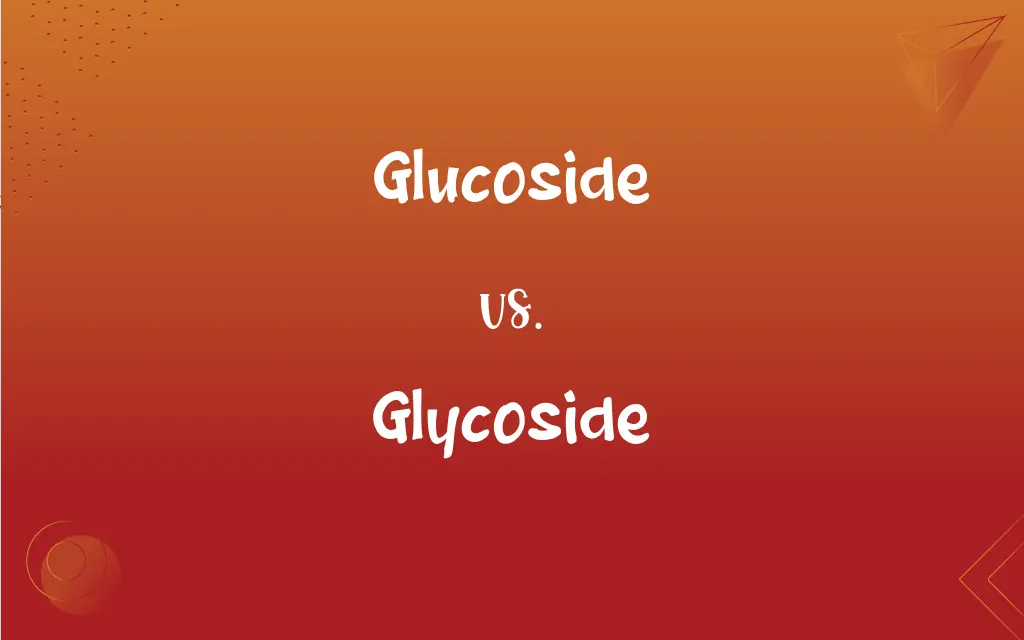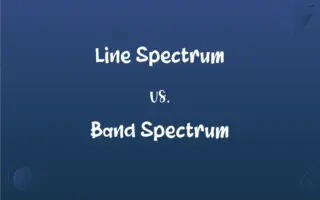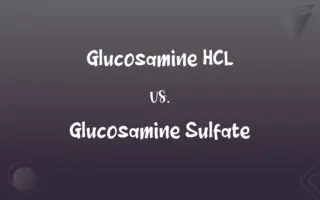Glucoside vs. Glycoside: What's the Difference?
Edited by Aimie Carlson || By Harlon Moss || Published on January 6, 2024
Glucosides are glycosides specifically with glucose as their sugar component, while glycosides are compounds formed from a sugar and another molecule.

Key Differences
Glucosides are a specific type of glycoside where the sugar part is glucose. These compounds are common in plants and serve various biological roles. On the other hand, glycosides can have any type of sugar, like fructose or galactose, linked to another non-sugar molecule, making them a broader category.
In glucosides, glucose is bonded to another molecule, often a non-carbohydrate such as a flavonoid or alkaloid, which can influence the compound's properties and biological activities. In contrast, glycosides may contain different sugars, and this variation greatly influences their physical, chemical, and biological properties.
The role of glucosides in plants includes defense mechanisms against herbivores or pathogens, and they can have medicinal properties. Glycosides, encompassing a wider variety of compounds, play diverse roles in biological systems, from energy storage to cell recognition and signaling.
Glucosides often impart flavors or colors to plants and can be used in food and medicine. The specific sugar in glycosides affects solubility, stability, and how the body metabolizes these compounds, making them significant in pharmacology.
When isolated, glucosides can be used in various applications, including natural sweeteners or therapeutic agents. Glycosides, depending on their sugar and aglycone parts, are used in a wide array of applications, from sweeteners to heart medications.
ADVERTISEMENT
Comparison Chart
Sugar Component
Always glucose
Can be any sugar
Chemical Structure
Glucose linked to another molecule
Sugar linked to a non-sugar molecule
Biological Role
Defense, flavor, and color in plants
Diverse roles including signaling and energy storage
Applications
Natural sweeteners, medicine
Wide range, from medicine to food industry
Chemical Diversity
Limited by glucose component
Highly diverse due to various sugars
ADVERTISEMENT
Glucoside and Glycoside Definitions
Glucoside
A compound with glucose linked to another molecule.
Amygdalin, a cyanogenic glucoside, is found in bitter almonds.
Glycoside
Diverse group of chemicals important in plant and animal biology.
Saponins, glycosides in soapberries, create a foaming action.
Glucoside
Compounds in plants affecting taste and color.
Anthocyanin glucosides contribute to the red color in raspberries.
Glycoside
A compound where a sugar is bonded to a non-sugar molecule.
Digoxin, a cardiac glycoside, is used to treat heart conditions.
Glucoside
Naturally occurring chemicals in plants, often for defense.
Salicin, a glucoside in willow bark, has pain-relieving properties.
Glycoside
Molecules playing a role in cell recognition and signaling.
Glycolipids, glycosides in cell membranes, help in cell signaling.
Glucoside
Chemicals that can release glucose upon hydrolysis.
The glucoside arbutin is used in skin-lightening products.
Glycoside
Compounds that can be hydrolyzed to release a sugar.
The glycoside coumarin is used for its pleasant fragrance.
Glucoside
A type of glycoside specifically containing glucose.
The glucoside stevioside is used as a natural sweetener.
Glycoside
Chemicals with applications in medicine and nutrition.
Starch, a polysaccharide glycoside, is a major food energy source.
Glucoside
A glycoside, the sugar component of which is glucose.
Glycoside
Any of a group of organic compounds, occurring abundantly in plants, that yield a sugar and one or more nonsugar substances on hydrolysis.
Glucoside
(biochemistry) A glycoside that yields glucose after hydrolysis.
Glycoside
A molecule in which a sugar group (the glycone) is bound to a non-sugar group (the corresponding aglycone) by a nitrogen or oxygen atom. Glycosides yield a sugar after undergoing hydrolysis.
Glucoside
One of a large series of amorphous or crystalline substances, occurring very widely distributed in plants, rarely in animals, and regarded as influental agents in the formation and disposition of the sugars. They are frequently of a bitter taste, but, by the action of ferments, or of dilute acids and alkalies, always break down into some characteristic substance (acid, aldehyde, alcohol, phenole, or alkaloid) and glucose (or some other sugar); hence the name. They are of the nature of complex and compound ethers, and ethereal salts of the sugar carbohydrates.
Glycoside
A group of compounds derived from monosaccharides
Glucoside
A glycoside derived from glucose
FAQs
What is a glucoside?
A compound where glucose is attached to another molecule.
Do glycosides always contain glucose?
No, they can contain different types of sugars.
How are glucosides used in plants?
As defense mechanisms and for imparting color/flavor.
Are glucosides water-soluble?
Many glucosides are due to the glucose component.
What are the medicinal uses of glucosides?
They are used in heart medications, sweeteners, and more.
Can glycosides be toxic?
Some, like cyanogenic glycosides, can be toxic.
Can glycosides be used in skincare?
Yes, some glycosides have skin-lightening or antioxidant properties.
What is a glycoside?
A molecule with a sugar attached to a non-sugar substance.
Are glycosides important in human biology?
Yes, they play roles in metabolism, cell signaling, and more.
How do plants produce glucosides?
Through biosynthetic pathways involving glucose.
Can all glucosides be considered glycosides?
Yes, all glucosides are a type of glycoside.
Are glycosides found in all plants?
Many plants contain them, but not all.
How are glycosides isolated for use?
Often through extraction and purification from plants.
How are glycosides used in the food industry?
As sweeteners, flavor enhancers, and preservatives.
What is the role of glucosides in plant defense?
They can deter herbivores or inhibit microbial growth.
Are glucosides stable under heat?
Stability varies; some are heat-sensitive.
Can glycosides help in disease prevention?
Certain glycosides have been studied for health benefits.
What is an example of a glucoside in food?
Stevioside, a sweetener derived from the stevia plant.
Can glucosides be synthesized artificially?
Yes, some can be synthesized in laboratories.
Do glycosides have a role in animal digestion?
Yes, they can influence gut bacteria and digestion.
About Author
Written by
Harlon MossHarlon is a seasoned quality moderator and accomplished content writer for Difference Wiki. An alumnus of the prestigious University of California, he earned his degree in Computer Science. Leveraging his academic background, Harlon brings a meticulous and informed perspective to his work, ensuring content accuracy and excellence.
Edited by
Aimie CarlsonAimie Carlson, holding a master's degree in English literature, is a fervent English language enthusiast. She lends her writing talents to Difference Wiki, a prominent website that specializes in comparisons, offering readers insightful analyses that both captivate and inform.






































































